Crypts And Blood: A Creepy Crawl Through The History Of Horror Hosts
Published on September 29th, 2011 in: Halloween, Horror, Movies, The Internets, TV |By Cait Brennan
“There’s nothing on,” you say. A strangely common complaint in an era with hundreds, if not thousands, of 24-hour-a-day channels. Once upon a time, there was literally nothing on, because the two or three local stations your town was lucky to have would shut their transmitters off at 11 p.m. Stations invented every possible kind of stunt (up to and including running the weatherman’s home movies) to fill airtime, but eventually the exhausted staff would finish the late local news, have a priest give a drunken invocation, run the national anthem, and pull the damn plug.
But as the signals died, there through the flickering static, in the dark dead of night, one station would keep its dim light on, transmitting faded images of 1930s ghouls into your darkened living room. Then, out of the black, when it all started getting just a little too real, some character covered in blood cut their way into the movie and cracked wise. You’ve just met your horror host, and whether your movie was terrifying or just terrifyingly awful, spooky late nights never had a better friend.

Vampira
The horror host tradition began in 1954 with Vampira, a character brought to life by Maila Nurmi, best known to contemporary audiences from her appearance in Ed Wood’s Plan 9 from Outer Space. Inspired not just a little by the delightfully dark Charles Addams cartoons (and predating Carolyn Jones’ Morticia Addams by a decade), Nurmi crafted the character for Hollywood’s annual Bal Caribe costume ball in 1953. Nurmi’s ghoul woman won best costume (out of a field of 2,000), and was soon approached to bring the character to television. As Vampira, Nurmi combined dark, macabre elements with fetish sensibility and a droll, deadpan sense of humor that spared no subject, from the film to the advertisers to the audience itself. A true pioneer, Vampira ran for a year on KABC and was revived on competitor KHJ in 1956. Her success, while short-lived, soon had national repercussions.
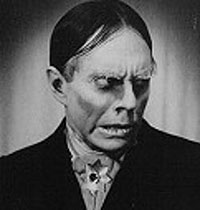
Zacherle
In 1957, Screen Gems spent a staggering (for 1957) $20 million for a ten-year license of the television rights to 550 films from the Universal library. The studio then did something even weirder: it bundled up the films according to genre and then hawked them to content-starved local stations. All those classic (and less classic) Universal horror films were packaged as “SHOCK!” and sent out to stations across the country as late-night programming with a suggestion straight out of Vampira’s playbook: have somebody on your staff “host” the films, preferably in character. Across the country, tightwad station managers stuck fright wigs on their weekend weatherman and shoved them in front of the camera. Shock Theater was born.
To the surprise of many, the experiment was a . . . monster hit. Local ratings skyrocketed, and anywhere from 25 to 50 percent of people watching television at the time were tuned in. The (literally) overnight sensation sent shockwaves through the culture, renewing national interest in classic horror. Within a year, Hollywood had rushed dozens of new horror films into production, horror re-releases flooded theaters, and Forrest J. Ackerman launched his Famous Monsters of Filmland magazine, which brought the genre and its fandom together for the first time (it continues today in revived form).
And the horror hosts became instant pop-culture sensations. Philadelphia had Zacherle (a.k.a. Roland) the Cool Ghoul, whose horror-comedy skits were never short on simulated gore and surreal humor. Zacherle became an immediate sensation, eventually moving to New York and landing a Top Ten radio hit (“Dinner with Drac,” in conjunction with pal and fellow Philly TV legend Dick Clark), numerous comedy albums, and a slew of merchandise, even starring in cinematic classics such as 1981’s Geek Maggot Bingo. Now 92, Zacherle continues to maintain a robust appearance schedule for several generations of adoring fans.
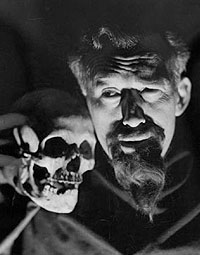
Ghoulardi
There were as many approaches to the horror host gig as there were horror hosts. Ghoulardi, conjured with manic glee by Ernie Anderson, was perhaps the greatest hipster in history, long before a generation of bearded Brooklynites gave the word its current connotation. Anderson’s Ghoulardi spun rock and roll records during (and often over) the movies, used chroma-key to cut himself into the action, demolished “unhip” targets from Mike Douglas to Lawrence Welk, and spouted an amazing hepcat patois that had a generation of young Cleveland rockers saying “stay sick!” to unsuspecting squares. (The Cramps, Pere Ubu, and the electric eels were all fans.) Anderson had explosives and wasn’t afraid to use them, detonating any unsuspecting object that had the misfortune to be within arm’s reach during a broadcast. In 1966, Anderson moved to Hollywood, following his longtime pal and collaborator Tim Conway, who had already found mainstream success (on McHale’s Navy). While Anderson didn’t fare as well in front of the camera, generations of viewers know his voice from his years as staff announcer for ABC in the 1970s (“. . . on the Loooooove Boat!”), and his son Paul Thomas Anderson reportedly makes movies of some sort.
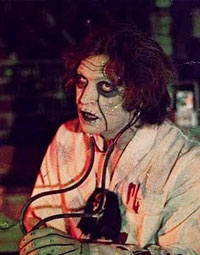
Dr. San Guinary
Omaha’s Dr. San Guinary began as a truly scary character. Portrayed by KMTV’s staff producer John Jones, Creature Feature‘s Dr. San was a blood-soaked ghoul in a dungeon with his assistant/monster/experiment, Igor—always unseen except for the occasional creepy hand. Dr. San let loose with the wisecracks, but early 1970s technology rendered Dr. San in thick, unworldly greens and reds and shadows that made even a 10:30 Omaha Saturday night into a thing of terror. Over time, Dr. San became more of a comic character whose charity work in the Omaha area was the stuff of legend. Surviving clips, though, show that Dr. San never lost his adult edge. At the height of its popularity in 1975, Creature Feature regularly drew over 50% of Omaha’s viewing audience. The show left the air in 1982 and Jones passed away in 1988, but Creature Feature lives on in Omaha as a live stage show that debuted this year.
Of all the classic horror hosts, Bob Wilkins was perhaps the coolest—cool, in fact, to the point of practiced, winking indifference. There was no rubber mask, no Halloween makeup, no lab-OR-a-tory, no spooky, put-on Count Floyd voice. Wilkins was a well-dressed, somewhat nerdy guy with glasses and a cigar, sitting quietly in a chair, advising viewers that the movie they were watching was total crap, and that they should really turn the channel. Needless to say, no one did.
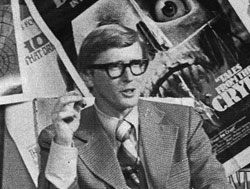
Bob Wilkins
Starting out in 1966 on Sacramento’s KCRA, Wilkins’ popularity was such that he was tapped to host the same show at Oakland’s KTVU; Wilkins made the commute and taped both shows for nearly ten years, when he handed the reins of KTVU’s Creature Features to the excellent John Stanley. Ironically, though Wilkins never donned a horror getup, Channel 2 did get him to dress up as a space hero: Captain Cosmic. Wilkins (and his washing-machine-turned-wonder-robot sidekick, 2T2) hosted an afternoon kids’ show that was head-and-shoulders above the standard Bugs Bunny package. Wilkins personally arranged for Bay Area kids to enjoy Japanese and UK imports like Ultraman, Star Blazers, Johnny Sokko and his Flying Robot, Spectreman, The Space Giants, and Gerry Anderson’s Supermarionation classic Captain Scarlet and the Mysterons. Wilkins retired from television in 1981 and passed away in 2009.
By the early 1980s it seemed the horror host tradition was beginning to wane. Cable TV began eating up the market for old movies (and driving up costs), and the advent of 24-hour local TV meant an endless supply of cheap sitcom and western reruns. But in 1981, LA’s KHJ-TV (later KCAL-9) contacted Maila Nurmi about reviving the classic Vampira show. Nurmi agreed, and production began on a revival, but the show soon fell apart under murky circumstances. Some say Nurmi insisted KHJ hire popular Cuban-American dancer-comedienne-multihyphenate-sensation Lola Falana to play Vampira; Nurmi claimed KHJ hired a new actress, Cassandra Peterson, without consulting her. Nurmi withdrew herself—and the Vampira name—from the project.
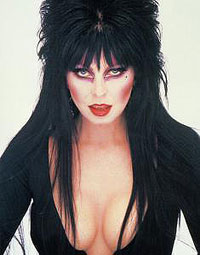
Elvira
Peterson and her collaborator Robert Redding overhauled the character, bringing a punky ’80s L.A. sensibility and a pun-heavy sense of humor together with a formidable costume choice, and Elvira, Mistress of the Dark was born. Vampira sued, but lost. Elvira’s Movie Macabre ran on KHJ for four years, but Elvira became a marketing juggernaut that was inescapable in the ’80s and ’90s, through albums, feature films, cameos, DVDs, and live appearances. Elvira’s costume continues to be the number one selling Halloween costume of all time, and her Movie Macabre was recently revived in syndication.
Jaded contemporary audiences weaned on “torture porn” and other modern horror staples might say that there was no true terror on late-night Shock Theater shows. Those audiences have clearly never met Edmus Scary, a prolific horror host who worked in numerous markets from the 1960s to the 1980s, from San Diego to Kansas City to Phoenix. The real-life Ed Muscare, it turned out, wasn’t moving from job to job just by popular demand. The genuinely creepy horror host (and, alarmingly, children’s TV host) was a genuine creep, leaving not just jobs but jurisdictions, allegations, and scandals in his wake. Convicted of sexual battery on a teenage boy in 1987, Muscare later became perhaps the most disturbing Internet sensation of all time (with apologies to Mr. Goatse), earning millions of views for his creepily nonsensical YouTube videos (dubbed the “Singing Sex Offender”) until a judge ordered him to stop. At which point he kept doing it by proxy and was sentenced to prison for probation violations. Nothing in Dracula’s dungeon could compete with that.
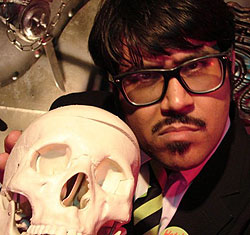
Mr. Lobo
Unlike most of the staples of 20th century television (soap operas, educational programming, local kids’ shows, public affairs programming, coherent local news), the horror host tradition continues to thrive on both broadcast and cable TV. In addition to the Elvira revival, Chicago’s Svengoolie (whose roots date back to 1973) airs nationally on the MeTV network of digital subchannels, terrifying and delighting fans from Boston to Berwyn and single-handedly keeping the rubber chicken industry afloat.
Some markets even continue to produce local shows. San Francisco’s reliably offbeat indie station KOFY has Creepy KOFY Movie Time, featuring Live 105 DJ “No Name'”and Balrok, a demon who lives underneath the station. The proceedings have a decidedly lad-mag rock and roll bent, with copious “hot chicks,” beer, and frat-style humor from local comics.
At the other end of the spectrum is Mr. Lobo, the host of the nationally syndicated Cinema Insomnia. A dapper horror host in the Bob Wilkins tradition, Lobo is a tireless ambassador for the genre, making numerous appearances at conventions and live stage shows. Cinema Insomnia is chock full of knowing references to the genre, surrounding its “misunderstood” (not “bad”) movies with vintage public service announcements and an impressive array of ancient commercials and shorts, as well as a seemingly sentient houseplant called Miss Mittens. The show recently completed a successful Kickstarter campaign to fund its 10th anniversary season. In addition to his broadcast outlets, Lobo’s innovative Internet distribution model—and the wave of like-minded DIY Internet horror hosts sharing their love of bad movies with the world—proves the horror host is truly the cinematic monster that would not die.
For a comprehensive look back at the history of horror hosts, check out Wikipedia.
Time limit is exhausted. Please reload the CAPTCHA.